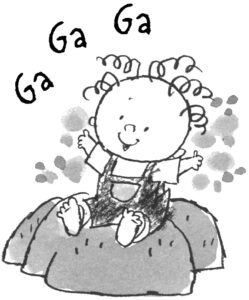
Late-Talking Toddlers: How the Baby Signs® Program Can Help
By: Catherine Brown, M.A., CCC-SLP
Speech-language pathologists refer to children as “late-talkers” when they are slower to develop verbal/expressive skills than their peers even though they have very good receptive (language comprehension) skills. This pattern distinguishes them from “language-impaired” children who have significant deficits in both language comprehension and production.

In contrast to language-impaired children, most late-talkers do eventually catch-up to their peers in language skills, often without intervention. However, the frustration that late-talkers feel before they catch up can lead to negative interactions with others that leave lasting impressions. For that reason, helping late-talkers overcome their problem as quickly as possible is in everybody’s best interest.
To find out if the Baby Signs® Program would help such children, I completed a Masters Thesis using a research design parallel to that used by Drs. Acredolo and Goodwyn in their NIH study. The fifteen children in my study all fit the formal criteria for “late-talkers”—being significantly behind same-age peers in expressive vocabulary but not for receptive language. Of these fifteen families, five received training in the Baby Signs® Program, five received traditional training emphasizing verbal interaction only, and five received no intervention at all.
Over the course of the 8-month study, all three groups of late-talkers were compared with two other groups of children: (a) children of the same age who were developing normally (Age-Matched), and (b) younger children who were at the same level of expressive vocabulary (Language-Matched) as the late-talkers.
When comparing the expressive vocabularies of the groups four months after the study began, the results provided support for the utility of the Baby Signs® Program as an intervention with late-talkers. Specifically, the signing group was the only group whose average expressive vocabulary score was no longer significantly behind their age-matched peers. In contrast, the group experiencing the traditional verbal intervention and the group experiencing no intervention at all both remained significantly behind their same-aged peers with scores much closer to the younger, Language-Matched children at both the 4-month and 8-month follow-up.
In addition to helping boost their expressive language skills, the availability of signs also helped the families in the signing group deal with frustration and worry about their slow-to-talk children.
Once these parents were able to see how much about language their children did know, they were reassured, and once the children were able to use signs to get their needs met without tantrums and tears, family life was better for everyone.
In the years since completing my thesis project, I have used the Baby Signs® Program with many children in my clinical practice who show early language delays. I continue to find it an invaluable tool for families. However, I want to emphasize that any parents who have concerns about their child’s language development, or any other aspect of development, should consult a speech-language pathologist, developmental specialist, or their pediatrician for professional advice. Every state has programs available to provide services for families who would like help or information.
An especially useful resource for parents specifically concerned about their child’s language development is the American Speech-Language-Hearing Association (ASHA). They have a wonderful page on their website called “How Does Your Child Hear and Talk?” that includes a developmental chart. It helps parents decide when the time has come to seek professional help. Not only does the chart indicate when parents should seek such help, it also provides information to help them find an appropriate professional.
To obtain a single copy of this brochure, visit www.asha.org or contact the ASHA Action Center at 1-800-638-8255 or email actioncenter@asha.org.
Research and additional information
https://www.semanticscholar.org/paper/Impact-of-Symbolic-Gesturing-on-Early-Language-Goodwyn-Acredolo/a880c205413dc05c3743ea0d04ce834031958ffe
https://2gmc9b.p3cdn1.secureserver.net/wp-content/uploads/2023/05/Scientific-Research-0614.pdf
